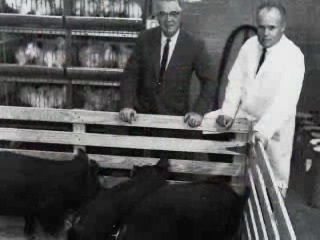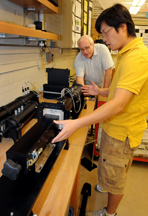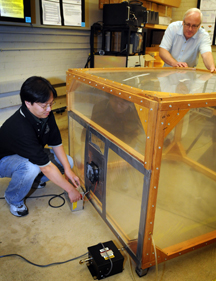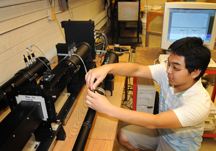
| VIDEO |
 * Herrick Labs' 50th anniversary draws engineers, industry leaders from around the world (3 minutes) * Herrick Labs' 50th anniversary draws engineers, industry leaders from around the world (3 minutes) |

July 2, 2008
Purdue's Herrick Labs turning 50, eyes future expansion
WEST LAFAYETTE, Ind. - |
oriented research in areas ranging from advanced automotive technologies to "smart" buildings, turns 50 in July with an eye toward the future.
"It isn't easy to balance the needs of industry, academics and basic research, but that's what Purdue has accomplished at Herrick Labs over the past 50 years," said Patricia Davies, Herrick director and a professor of mechanical engineering. "The labs have developed a formula for satisfying the practical requirements of industry without compromising the academic standards of Purdue's faculty and students."
Herrick is holding a two-day 50th anniversary celebration, with lab tours and events for alumni and culminating in a "birthday banquet" on July 19.
The laboratories were established in the 1950s with a grant from Ray W. Herrick, then CEO of Tecumseh Products Co., in Tecumseh, Mich. Since then, about 600 Herrick students have completed graduate and doctoral degrees.
 |
"Herrick Labs is a place where students learn about industry-relevant problems and contribute, through their research, to solving these problems," said Leah Jamieson, the John A. Edwardson Dean of Engineering and Ransburg Distinguished Professor of Electrical and Computer Engineering. "Herrick graduates are valued for their technical expertise and know-how for making products more efficient, more environmentally friendly and more people friendly."
The labs were spawned from the marriage of two distinctly different disciplines.
"Herrick was ahead of its time because it started as an interdisciplinary collaboration when it wasn't fashionable to do so," Davies said. "An animal sciences professor and a mechanical engineering professor got together to study the effects of climate on animals."
The mechanical engineering professor, William Fontaine, mentioned the concept to Ray Herrick one summer while he was visiting Tecumseh Products to explore research relationships. The CEO liked the idea and donated enough money to start the labs.
"Today, of course, interdisciplinary research and vital ties to industry are the foundation of Purdue's Discovery Park, but Herrick was really founded on the same principle many years ago," Davies said. "And we're still very interdisciplinary."
 |
Projects involve collaborations with faculty specializing in areas including engineering disciplines; speech, language and hearing sciences; and psychology.
The July anniversary celebration is taking place in conjunction with air conditioning and refrigeration conferences that are drawing hundreds of researchers to Purdue from 30 countries. About 500 people are expected to attend the 12th International Refrigeration and Air Conditioning Conference and the 19th International Compressor Engineering Conference on July 14-17. Researchers and industry executives from around the globe, including North America, Europe, Asia and South America, will present talks.
The conferences reflect Herrick Labs' worldwide industrial reach, Davies said.
Among the labs' more than 120 past and present sponsors are companies in Canada, Japan, Germany, Brazil, Korea and Denmark. One Indiana company that has taken advantage of Herrick's expertise is Cummins Engine Co. Inc. in Columbus, a leading manufacturer of diesel engines that employs many Purdue graduates in Indiana.
"All of our research has synergy with industry needs," Davies said. "For example, new concepts using theoretical modeling and advanced experimental techniques developed at the laboratories continue to have a great impact on the design of cars and trucks and equipment used in heating, ventilating, air conditioning, refrigeration and other systems."
 |
Current research areas include:
* Developing new types of compressors for air conditioners and refrigerators that are more environmentally friendly, energy efficient, compact and quiet than conventional compressors.
* Creating "smart" equipment that reduces energy demand for commercial buildings when electricity rates are highest, during times of peak demand in summer months.
* Developing a system to monitor and improve indoor air quality using mathematical models and sensors. Such a system could be used in buildings and commercial airliners to detect the release of hazardous materials or pathogens.
* Developing more fuel-efficient internal combustion engines for cars and trucks that emit less pollution.
* Creating pavements and tires that make less noise, as part of research affiliated with the Institute for Safe, Quiet and Durable Highways, sponsored by the U.S. Department of Transportation.
* Developing systems that use sensors and computational models for the early detection of damage in automotive and aircraft parts. The systems are designed to avert catastrophic structural failure in military vehicles and aircraft while reducing the need for expensive scheduled maintenance in commercial vehicles.
* Research from a diverse range of disciplines, from mechanical engineering to psychology, collaborating to gain a better understanding of how humans perceive and are affected by machines and engineered systems. The work includes learning how people perform behind the wheel of a car and in the workplace and how perceptions shape consumer attitudes toward products. Researchers are developing models of perceptual and human decision making processes and integrating them with engineering models to help improve product design.
* Using room-size climate control chambers to study heating, ventilation, refrigeration and air conditioning problems.
As the birthday celebration draws near, plans also are being drawn up for a new building. The Herrick Labs are housed in a brick horse barn originally built a century ago near State Street and Russell Drive.
"We are raising funds to expand the laboratories," Davies said. "The current building's infrastructure and utilities currently limit the scope of research that we can do. Given the special-purpose facilities needed for much of our research, this is a challenging endeavor.”
Herrick has raised $9 million toward a goal of $11 million for the first phase. Groundbreaking is scheduled for the fall.
Plans for the new building call for approximately doubling the floor space from the current 27,500 square feet to around 52,000 square feet. The project is currently in the architectural-selection process to develop plans for the new building; the first phase is expected to encompass around 16,000 square feet and will include a Cummins engine laboratory and the Perception-Based Engineering Laboratory. Other details, however, and a completion date are not yet known.
The new building, currently planned to be located adjacent to Herrick south of State Street between Martin Jischke Drive and Steven Beering Drive, will house offices and experimental facilities for more than 90 graduate students, 25 faculty, postdoctoral researchers and visiting researchers, as well as technical and administrative staff.
"The wide scope of the research conducted at the laboratories will require demanding specifications for the new building, in particular, the need for acoustic and vibration isolation in various parts of the building," Davies said. "Some areas will require background noise and vibration levels to be below human perception thresholds, and in these areas an ability to precisely control environmental parameters will be critical."
The offices and meeting rooms at the new Herrick Labs also will constitute a "living" laboratory that will help bridge the gap between new prototype technologies arising from fundamental research and those technologies used in new buildings.
"This will involve reconfigurable heating, ventilation and cooling systems, and building envelopes so that new concepts can be tried out in a realistic setting," Davies said. "Actual energy efficiency, occupant comfort and productivity in a working building can be monitored and the information used to make refinements to proposed technologies. This will ensure much more successful and predictable implementation of new technologies in buildings. "
Designs will address issues including water conservation, natural lighting, using recycled materials, and other steps to conserve energy and resources. The building will be LEED certified, an acronym for leadership in energy and environmental design. The certification was developed by the U.S. Green Building Council, a nonprofit organization dedicated to sustainable building design and construction.
"The overall concept behind the new Herrick labs is to go 'beyond green,' learn through research how to further increase energy efficiency and lower environmental impact but also integrate occupant comfort and productivity into building design objectives so that you design spaces that people actually want to be in," Davies said. "The living lab is important because we want to be able to demonstrate that concepts work and identify where the problems are so that they can be addressed."
The building will be the second LEED-certified facility on campus, behind the Roger B. Gatewood Wing of the Mechanical Engineering Building, expected to be completed by the summer of 2011.
Davies' personal research is associated with the Perception-Based Engineering Lab, which concentrates on learning how people react to a product and their environment.
"If you are designing products that impact people, it makes sense to study how people perceive factors such as sound, vibration, temperature, lighting and other elements," she said. "Then you can integrate human experience into the design of products.
"The new facility will enable us to study issues in a much more multimodal way so we could study sound and vibration together, or vision and noise, or we could look at productivity in a noisy, hot and humid environment and examine tradeoffs between thermal and acoustic comfort or air quality. We will look at the effects of the environment on the people working in them in terms of comfort, productivity and health."
The anniversary celebration will include a barbecue and tours of the Envision Center, Ross-Ade Stadium and Herrick Labs on July 18 and a July 19 tour of the Birck Nanotechnology Center and Boilermaker Express sightseeing rides.
People interested in touring the labs can contact Donna Cackley, (765) 494-2133, cackley@purdue.edu .
Writer: Emil Venere, (765) 494-4709, venere@purdue.edu
Sources: Patricia Davies, (765) 494-9274, daviesp@purdue.edu
Leah H. Jamieson, (765) 494-5346, ljh@purdue.edu
Purdue News Service: (765) 494-2096; purduenews@purdue.edu
Note to Journalists: Video b-roll is available, as are historic photos, by contacting Emil Venere, (765) 494-4709, venere@purdue.edu .
PHOTO CAPTION:
Researchers at Purdue's Ray W. Herrick Laboratories are developing fuel-flexible combustion control strategies that enable highly efficient, ultra-low emission combustion of both conventional and domestically available alternative diesel fuels, including biodiesel and coal-derived liquid fuels. Gregory Shaver, at right, an assistant professor of mechanical engineering, works with graduate students Gayatri Adi, left, and Mike Bunce to prepare for biodiesel testing with a 2007 Cummins turbo-diesel engine. Graduate student Karla Stricker, in window at right, monitors data acquisition. (Purdue News Service photo/David Umberger)
A publication-quality photo is available at https://www.purdue.edu/uns/images/+2008/shaver-HerrickAdv.jpg
PHOTO CAPTION:
Purdue mechanical engineering doctoral student Taewook Yoo and J. Stuart Bolton, a professor of mechanical engineering, prepare to operate a system that measures the acoustical properties of new perforated, acoustical materials at the university's Ray W. Herrick Laboratories. The engineers are using the system in research to develop new, space-efficient materials that make for quieter environments, such as the interior of a car, aircraft or building. Bolton is leading the research. (Purdue News Service photo/David Umberger)
A publication-quality photo is available at https://www.purdue.edu/uns/images/+2008/bolton-tube.jpg
PHOTO CAPTION:
Purdue mechanical engineering doctoral student Yoon-Shik Shin and J. Stuart Bolton, a professor of mechanical engineering, work on a system that measures how much sound a typical computer fan makes. The research, based at Purdue's Ray W. Herrick Laboratories, aims to reduce noisy office and home environments where audio-visual and information technology equipment is used. (Purdue News Service photo/David Umberger)
A publication-quality photo is available at https://www.purdue.edu/uns/images/+2008/bolton-cube.jpg
PHOTO CAPTION:
Purdue mechanical engineering master's student Kang Hou places a testing sample inside a system that measures the acoustical properties of materials at the university's Ray W. Herrick Laboratories. The engineers are developing more accurate methods for quantifying materials that will be used to create quieter environments in transportation and building systems. Professor J. Stuart Bolton is leading the research. (Purdue News Service photo/David Umberger)
A publication-quality photo is available at https://www.purdue.edu/uns/images/+2008/bolton-student.jpg
To the News Service home page
If you have trouble accessing this page because of a disability, please contact Purdue News Service at purduenews@purdue.edu.
